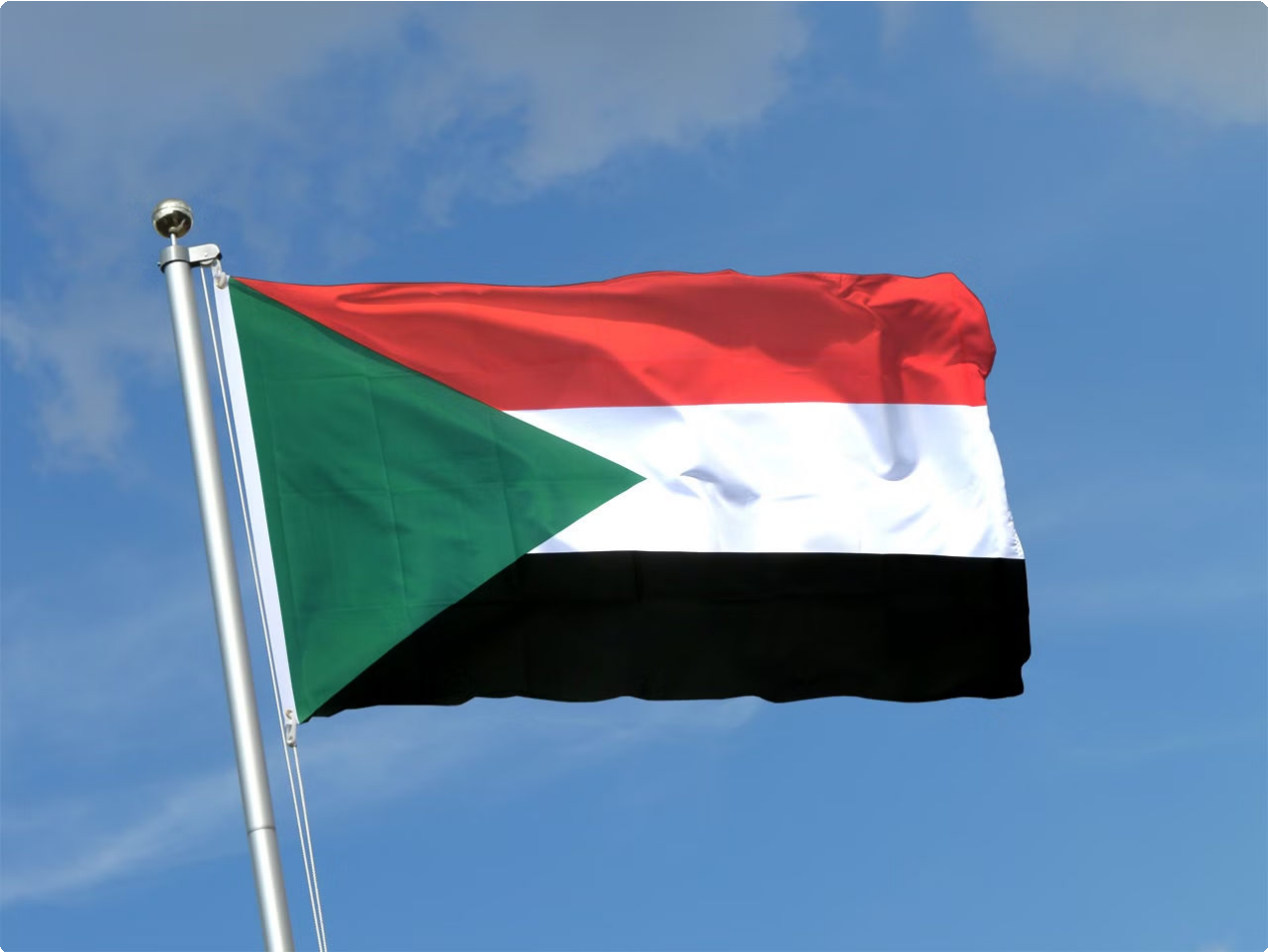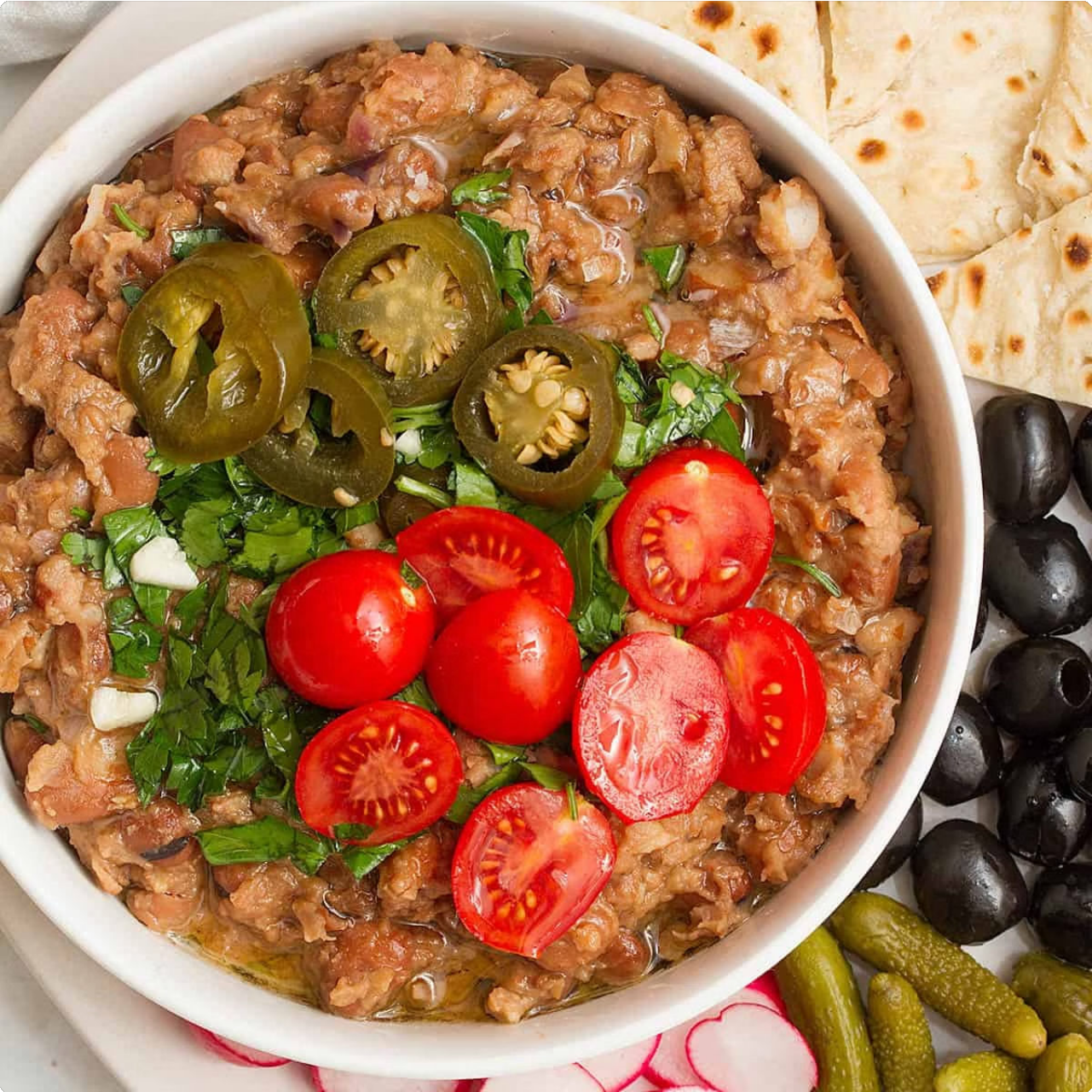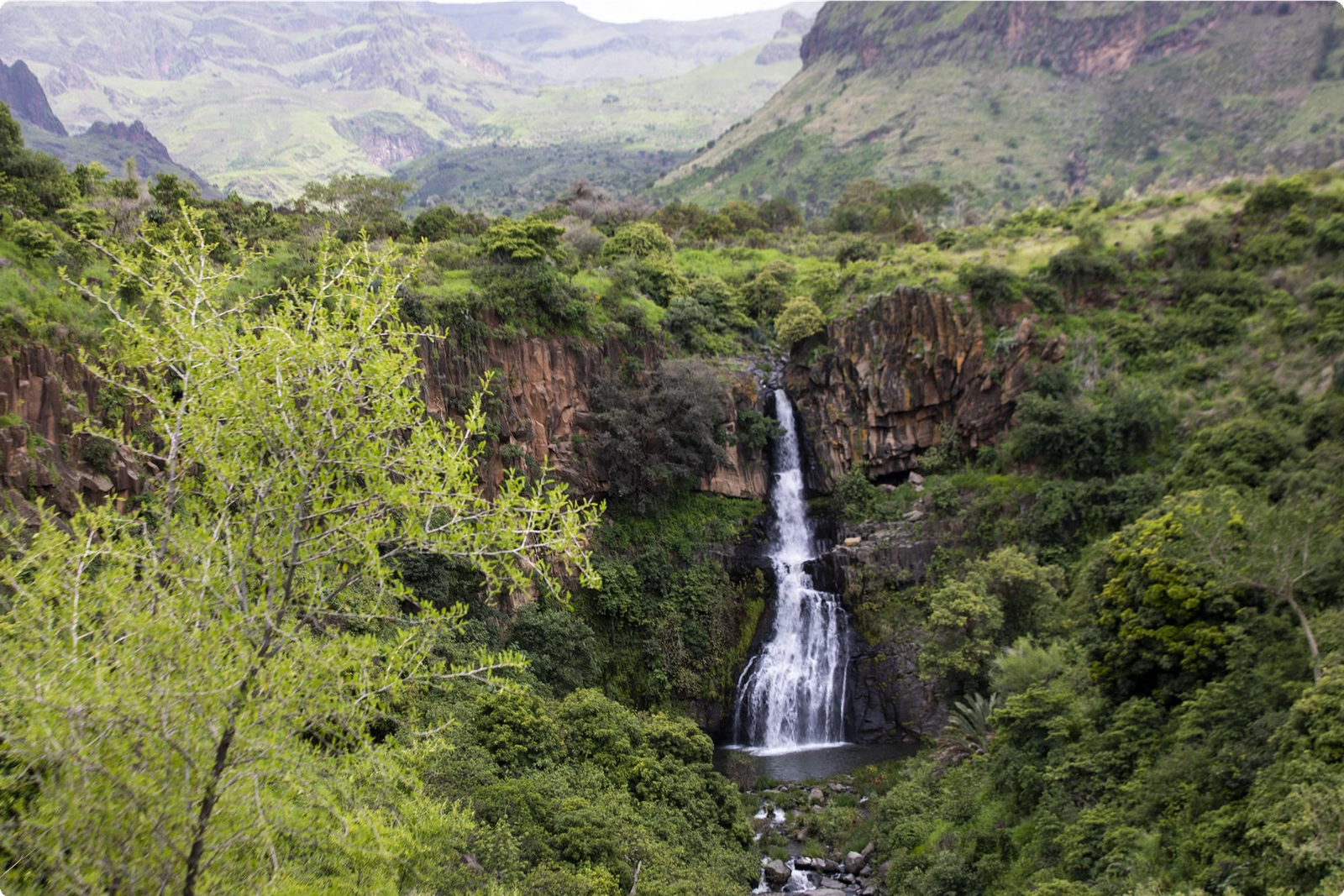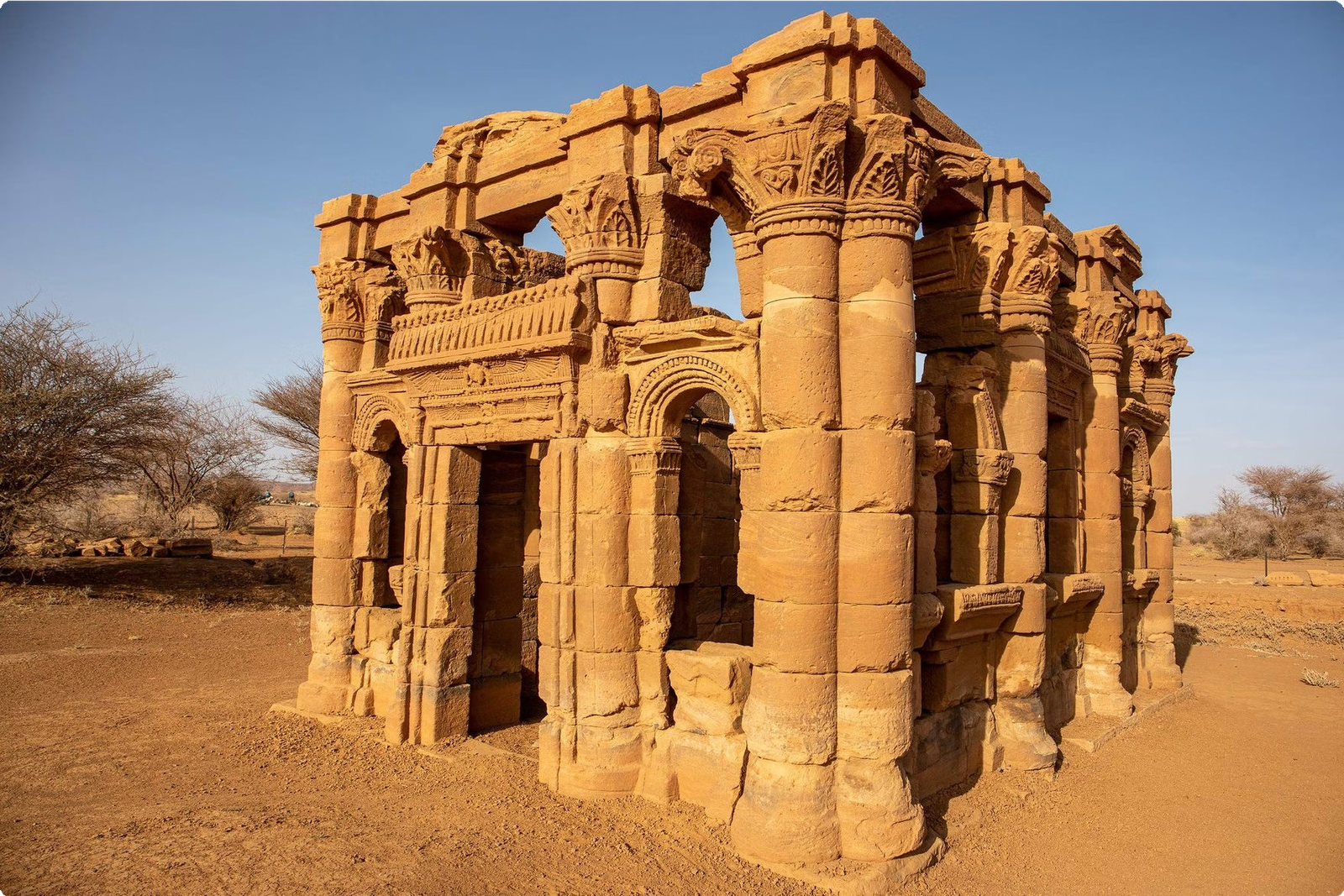Sudan
Discover Sudan
Sudan, officially the Republic of the Sudan, is a country in Northeast Africa. It is bordered by Egypt to the north, the Red Sea to the northeast, Eritrea and Ethiopia to the east, South Sudan to the south, the Central African Republic to the southwest, Chad to the west, and Libya to the northwest. With a population of approximately 44 million people, Sudan is ethnically and culturally diverse, with over 19,500 recorded ethnic groups.

The country has a rich history and is known for its unique blend of traditions, including ancient Nubian civilizations, Islamic influence, and diverse tribal customs. Sudan also boasts a varied landscape, from the Nile River and its tributaries to the Red Sea hills and the Sahara Desert, making it a fascinating and picturesque destination.
Sudanese Flag and National Symbols
The flag of Sudan consists of three horizontal stripes of red, white, and black colors. The red color represents the struggle for independence and the martyrs who sacrificed their lives, while the white symbolizes peace, optimism, and light. The green triangle on the left-hand side of the flag represents Islam, agriculture, and the prosperity of the nation. It also contains a yellow five-pointed star that stands for diversity and represents the five main regions of Sudan – central, eastern, northern, western, and southern.

In addition to the flag, Sudan also has national symbols such as the Sudanese rose, representing natural beauty, and the national bird, the Lilac-breasted Roller, symbolizing freedom and natural heritage. These symbols are deeply rooted in the culture and history of Sudan and hold significant meaning for the people.
Geography and Map of Sudan
Sudan, located in northeastern Africa, is the third largest country on the continent, covering an area of approximately 1.886 million square kilometers. It shares its borders with Egypt, Libya, Chad, Central African Republic, South Sudan, Ethiopia, Eritrea, and the Red Sea. The geographic landscape of Sudan is characterized by the Nile River, which flows through the country from south to north, providing essential water resources for agriculture and sustaining human life.

The diverse topography of Sudan includes deserts, mountains, savannas, and the fertile Nile Valley. The Sahara Desert dominates the northern region, while the southern part of the country consists of tropical forests and grasslands. Sudan’s geographic location and natural resources have contributed to its historical significance as a vital hub for trade and commerce.
The map of Sudan showcases its unique geographical features and highlights the significant landmarks, water bodies, and divisions within the country. It illustrates the strategic positioning of Sudan and its distinct topographical regions, offering valuable insights into the nation’s physical characteristics and spatial layout.
Overview of Sudanese Currency
Sudan’s official currency is the Sudanese pound, denoted by the symbol SDG. The Sudanese pound is further subdivided into 100 smaller units called piastres. It is issued by the Central Bank of Sudan and is used as the primary form of legal tender in the country. The physical banknotes and coins come in various denominations, with the design showcasing aspects of Sudanese culture, history, and natural resources.

The exchange rate of the Sudanese pound to other major currencies fluctuates due to various economic factors. Foreign exchange bureaus and banks facilitate currency exchange for tourists and visitors. It’s important for travelers to be aware of the prevailing exchange rates and the authenticity of the currency they receive.
Sudanese Economy and Major Industries
Agriculture: Sudan’s economy is heavily reliant on agriculture, with products such as cotton, peanuts, sorghum, and sesame being major contributors to the country’s exports.
Petroleum and Mining: Sudan is rich in natural resources, particularly petroleum and gold. The oil industry plays a significant role in the economy, while gold mining has been a major source of revenue.
Textiles and Manufacturing: The textile industry is a significant component of Sudan’s economy, with the production of textiles, garments, and leather goods being prominent. Additionally, manufacturing industries are emerging, contributing to economic growth.
Services Sector: The services sector, including telecommunications, banking, and retail, plays a vital role in Sudan’s economy, contributing to employment and economic development.
Sudanese Culture and Traditions
Sudanese culture is a rich tapestry of diverse traditions influenced by the country’s history, religion, and ethnic groups. The culture encompasses a wide variety of customs, music, dance, cuisine, and festivals that reflect the country’s unique identity.
The Sudanese people are known for their hospitality and warmth, often welcoming guests with open arms and traditional coffee ceremonies. Family plays a central role in Sudanese culture, and many traditions and rituals are centered around familial ties and communal gatherings.
The country’s cultural heritage is also evident in its architecture, arts, and crafts, with intricate designs and vibrant colors adorning traditional clothing and buildings. Sudanese traditional music and dance are vibrant expressions of the culture, often accompanied by religious and historical significance.
One notable aspect of Sudanese culture is the celebration of various festivals and religious events, offering a glimpse into the country’s diverse traditions and customs.
Traditional Sudanese Dance Forms
Zar Dance
The Zar dance is a traditional healing ritual that originated in Sudan and is still practiced in the region. It is characterized by rhythmic movements and music, often accompanied by synchronized clapping and chanting. The dance is believed to have spiritual and therapeutic significance, with participants entering a trance-like state to heal ailments or seek protection from evil spirits.

Gumbe Dance
The Gumbe dance is a lively and energetic traditional Sudanese dance performed in various social and cultural events. It involves quick footwork, hip movements, and energetic gestures that express joy, celebration, and storytelling. The dance is often accompanied by vibrant music, including drumming and traditional Sudanese instruments.
Popular Sudanese Dishes and Cuisine
Ful Medames
Ful Medames is a traditional Sudanese dish made of cooked fava beans mixed with olive oil, lemon juice, and various spices. It is often served with hard-boiled eggs and fresh vegetables, providing a hearty and flavorful meal that is a staple in Sudanese cuisine.

Kisra
Kisra is a type of Sudanese flatbread made from fermented sorghum flour. It is a common accompaniment to many Sudanese dishes and is known for its slightly sour flavor and spongy texture, making it a unique and essential part of Sudanese cuisine.

Sudanese Music and Instruments
Traditional Music Bands
Traditional Sudanese music often involves the mesmerizing performance of music bands equipped with instruments like the oud, tar, and tambourine. The rhythmic beats and melodious tunes create an immersive experience, reflecting the rich cultural heritage of Sudan.
Oud Instrument
The oud, a traditional string instrument, holds a significant place in Sudanese music. Its resonating sound and intricate melodies are central to various Sudanese musical traditions, serving as an integral part of both classical and contemporary compositions.
Traditional Drums
Drums play a vital role in Sudanese music, adding a pulsating rhythm to the enchanting melodies. Different types of traditional drums, such as the goblet drum and frame drum, are skillfully played, infusing lively energy into the music.
Famous Sudanese Celebrities
Maisa Abd Elhadi
Maisa Abd Elhadi is a renowned Sudanese actress who has gained international recognition for her outstanding performances in films and television series. Her talent and versatility have made her a prominent figure in the entertainment industry, and she continues to inspire aspiring actors and actresses in Sudan and beyond.

Rasha Sheikh Eldin
Rasha Sheikh Eldin is a celebrated Sudanese musician known for her soulful and captivating music. Her unique blend of traditional Sudanese melodies with contemporary influences has made her a respected figure in the music scene, earning her a dedicated fan base both locally and internationally.

Best Time to Visit Sudan
When planning a trip to Sudan, it’s important to consider the best time to visit. The ideal time to explore Sudan is during the winter months, from November to February, when the weather is milder and more suitable for outdoor activities. During this time, temperatures are cooler, making it comfortable to visit the historical sites, natural wonders, and bustling cities.
It’s essential to avoid visiting during the summer months, particularly from May to September, as the temperatures can soar to extreme levels, making it challenging to engage in outdoor adventures. The scorching heat during this period can be quite taxing, especially when exploring the desert landscapes and arid regions of the country.
Visitors should also be mindful of the rainy season, which typically occurs from June to October, bringing occasional heavy downpours and potentially disrupting travel plans. Planning a trip during the drier months ensures a smoother and more enjoyable experience, allowing travelers to make the most of their time in Sudan.
Top Tourist Attractions in Sudan
Ancient Pyramids of Meroë
The ancient pyramids of Meroë, a UNESCO World Heritage site, are a breathtaking testament to the rich history of Sudan. These well-preserved pyramids date back to the Kingdom of Kush and offer a mesmerizing glimpse into the ancient Nubian civilization.

Port Sudan, Red Sea Beaches
The pristine beaches of Port Sudan along the Red Sea are a paradise for beach lovers and diving enthusiasts. The crystal-clear waters and vibrant marine life make it an ideal destination for water sports and relaxation.

Nile River, Khartoum
A leisurely cruise along the iconic Nile River in Khartoum offers a unique perspective of Sudan’s capital city. Visitors can witness the confluence of the Blue and White Nile while enjoying the tranquil beauty of the river.

Sanganeb Reef Lighthouse
The Sanganeb Reef Lighthouse, perched on a coral atoll in the Red Sea, is a marvel of engineering and serves as a beacon for sailors navigating the waters off the coast of Sudan. The surrounding coral reefs make it a top spot for diving and marine exploration.

Historical Sites and Landmarks in Sudan
Ancient Pyramids in Meroë
Meroë is home to a collection of about 200 ancient pyramids, which are smaller and steeper than their Egyptian counterparts. These impressive structures were constructed as tombs for the Kings and Queens of the Kingdom of Kush and are recognized as a UNESCO World Heritage site.
Temple of Amun at Jebel Barkal
Jebel Barkal was a major religious site during the ancient Egyptian era and is home to the ruins of the Temple of Amun. The temple, dedicated to the god Amun, features well-preserved hieroglyphics and intricate carvings, providing a fascinating glimpse into the religious beliefs of the time.

Nubian Pyramids at El Kurru
The Nubian pyramids at El Kurru are part of a larger royal necropolis and served as tombs for the Nubian kings and queens of the ancient Kingdom of Kush. These pyramids are known for their unique architectural style and intricate designs, making them a must-see for history enthusiasts.

Historic Architecture on Suakin Island
Suakin, an ancient port city on the Red Sea coast, boasts a wealth of historic architecture that reflects the city’s rich history as a prominent trading hub. Visitors can explore intricate coral buildings, ancient mosques, and remnants of a bygone era, transporting them back in time.
Natural Wonders and Parks in Sudan
Red Sea Beaches
The Red Sea coast in Sudan is home to stunning beaches with crystal-clear turquoise waters and pristine white sands. These beaches offer a tranquil escape and are perfect for swimming, snorkeling, and enjoying breathtaking sunsets.
Bayuda Desert
The Bayuda Desert, located in northeastern Sudan, features mesmerizing sand dunes and vast open landscapes. Visitors can experience the serenity of the desert, go on camel treks, and witness the captivating beauty of the desert sunrise and sunset.
Jebel Marra
Jebel Marra is a volcanic massif in the Darfur region of Sudan, known for its lush greenery, waterfalls, and unique eco-system. It’s a paradise for hikers and nature enthusiasts, offering breathtaking views and diverse flora and fauna.

The Sudd
The Sudd is the largest freshwater wetland in Sudan, teeming with wildlife and rich biodiversity. Visitors can explore the expansive marshes, observe unique bird species, and witness the traditional fishing methods practiced by local communities.

Best Cities to Visit in Sudan
Khartoum: The capital city of Sudan, where the Blue and White Niles meet, offering a vibrant cultural scene, traditional markets, and historic landmarks such as the Presidential Palace.
Omdurman: Known as the largest city in Sudan, it boasts bustling souks, the vibrant Omdurman Market, and the famous Mahdi’s Tomb, a significant historical site.
Port Sudan: As the main seaport of Sudan, it’s a gateway to the Red Sea, offering beautiful beaches, coral reefs, and water sports activities.
Nyala: The capital of South Darfur, known for its rich cultural heritage, traditional crafts, and the annual Nyala Festival, celebrating local art and customs.
Kassala: The third largest city in Sudan, renowned for its colorful markets, distinctive architecture, and proximity to scenic natural attractions like the Taka Mountains.
Khartoum, the capital city of Sudan
Khartoum, the largest city in Sudan, is situated at the confluence of the Blue Nile and White Nile rivers. The name “Khartoum” is derived from the Arabic word for “elephants’ trunk,” owing to the shape formed by the two rivers meeting. This vibrant city serves as the political, cultural, and commercial hub of the country.

With its rich history and diverse population, Khartoum offers a blend of traditional Sudanese culture and modern urban developments. Visitors to Khartoum can explore historical landmarks, bustling markets, and unique architectural marvels. The city boasts a thriving arts and music scene, with numerous galleries and performance venues showcasing Sudan’s creative talent.
The vibrant street life and delicious culinary offerings make Khartoum a captivating destination for travelers seeking an authentic taste of Sudanese culture. Additionally, the city’s strategic location along the Nile makes it a gateway to exploring the natural beauty and ancient wonders of Sudan.
From traditional coffee houses to modern skyscrapers, Khartoum encapsulates the dynamic spirit of Sudan, making it a must-visit destination for those eager to immerse themselves in the heart of this fascinating country.
Omdurman, the Largest City in Sudan
Omdurman is the largest city in Sudan and is located just west of the capital, Khartoum. This vibrant city is known for its rich history, bustling markets, and traditional Sudanese architecture. With a population of over 2.7 million, Omdurman is a major cultural and economic hub in Sudan.

The city is famous for its traditional souk (market), where locals and visitors can explore a wide variety of goods, including handcrafted items, textiles, spices, and traditional Sudanese attire. Omdurman also boasts numerous mosques, with the Grand Mosque of Omdurman being a prominent landmark.
Visitors to Omdurman can immerse themselves in Sudanese culture by experiencing traditional music and dance performances, as well as sampling authentic Sudanese cuisine. The city’s lively atmosphere and significant historical sites make it a must-visit destination for travelers interested in the heritage of Sudan.
Port Sudan, the main seaport of Sudan
Port Sudan is the principal seaport of Sudan, located on the Red Sea coast. It plays a crucial role in the country’s economy, serving as a vital gateway for international trade and commerce. The port is well- equipped to handle various types of cargo, including containers, bulk goods, and petroleum products.

With its strategic location and modern infrastructure, Port Sudan facilitates the import and export of goods, contributing significantly to Sudan’s maritime trade. The port is also a hub for transshipment, connecting Sudan to global markets and enabling efficient transportation of goods to and from the region.
Surrounded by picturesque coastal landscapes, Port Sudan offers a unique blend of commercial activity and natural beauty. Visitors can witness the bustling maritime operations while enjoying stunning views of the Red Sea and the nearby coral reefs, making it a noteworthy destination for both business and leisure travelers.
For a glimpse into the maritime culture and the economic pulse of Sudan, a visit to Port Sudan provides a captivating experience that showcases the country’s connection to the sea and international trade.
Nyala, the Capital of South Darfur
Nyala is the capital city of the South Darfur state in Sudan. It is situated in the southwestern region of the country and serves as an important administrative and economic hub. The city is known for its rich cultural heritage and vibrant local markets, offering a unique glimpse into traditional Sudanese life.
Visitors to Nyala can explore the diverse ethnic communities and experience the warm hospitality of the locals. The city is also a gateway to the stunning natural landscapes of South Darfur, including lush savannahs and picturesque mountain ranges.
Nyala presents a blend of modern development and preserved traditions, making it an intriguing destination for travelers seeking an authentic Sudanese experience. The city’s colorful festivals, traditional crafts, and delicious cuisine further enhance its appeal.
Kassala, the Third Largest City in Sudan
Kassala is a city located in eastern Sudan, situated near the border with Eritrea. It is known for its vibrant markets, rich history, and unique architecture. The city is characterized by its distinctive red clay houses, which create a picturesque and colorful backdrop. The vibrant atmosphere, combined with the blend of Sudanese and Eritrean cultures, makes Kassala a captivating destination for travelers.
The city boasts a bustling market where locals trade traditional goods, colorful fabrics, and a variety of spices, offering a glimpse into the daily lives of the people in this region. Additionally, Kassala is surrounded by scenic landscapes, including the nearby Taka Mountains and the Gash Delta. Nature enthusiasts can explore these natural wonders and enjoy the breathtaking views they offer.
Visitors to Kassala can also delve into its rich history by visiting attractions such as the old town, the Khatmiyya Mosque, and the ancient ruins of the Ottoman fortress. Each of these landmarks holds stories of the city’s past, providing insight into its cultural heritage and architectural significance.
Wadi Halfa, a border town in Northern Sudan
Wadi Halfa is a historical border town located in Northern Sudan. Situated on the banks of Lake Nubia, it has served as an important point of transit between Egypt and Sudan for centuries. The town has a rich cultural heritage and is known for its unique blend of Nubian and Sudanese influences.
Visitors to Wadi Halfa can explore the traditional Nubian architecture, characterized by intricately decorated mud-brick houses, vibrant markets offering local crafts, and the serene beauty of Lake Nubia. The town’s proximity to ancient archaeological sites and its positioning as a gateway to the Nubian Desert make it an intriguing destination for history enthusiasts and adventure seekers alike.
With its stunning sunsets over the lake, warm hospitality, and a fascinating blend of cultures, Wadi Halfa offers a captivating glimpse into the authentic charm of Northern Sudan.
At the heart of Wadi Halfa is a vibrant community with a deep connection to the land and its history, making it a compelling destination for travelers seeking an immersive cultural experience.
Jebel Barkal, an Ancient Nubian Site in Northern Sudan
Jebel Barkal, also known as Gebel Barkal, is an ancient archaeological site located in Northern Sudan. This UNESCO World Heritage site holds great historical significance, as it was once the center of the ancient Nubian city of Napata. The site is characterized by a distinctive sandstone rock formation rising abruptly from the surrounding desert, creating a striking landscape.
The area around Jebel Barkal is dotted with the remains of temples, palaces, and pyramids, offering a glimpse into the rich history of the Nubian civilization. Visitors to Jebel Barkal can explore the Great
Temple of Amun, the Temple of Mut, and the Temple of Mut Precinct, all of which are adorned with intricate carvings and hieroglyphics.
The site also features the Royal Cemetery of Napata, where the ancient Nubian kings were laid to rest. The iconic Jebel Barkal is often depicted in ancient Egyptian and Nubian art, symbolizing the divine significance attributed to the site in ancient times.
Meroë, an Ancient City and UNESCO World Heritage Site
Meroë is an ancient city located in Sudan and is recognized as a UNESCO World Heritage site. This historical site holds immense cultural significance, as it was once the capital of the Kingdom of Kush.
The city is renowned for its archaeological riches, including well-preserved pyramids and ancient artifacts that provide a fascinating glimpse into the history of the region.

The ruins of Meroë offer visitors a unique opportunity to explore the architectural marvels of the ancient civilization, marvel at the intricate designs of the pyramids, and gain insights into the customs and traditions of the Kingdom of Kush. The site stands as a testament to the rich heritage and legacy of Sudan and continues to captivate history enthusiasts and travelers from around the world.
Suakin, a Historic Port City on the Red Sea Coast
Suakin is a historic port city located on the Red Sea coast of Sudan. It was once a bustling trade hub and an important port for the region, connecting Africa with the Middle East and beyond. The city is known for its unique architecture, characterized by ancient coral buildings that reflect its rich history and cultural heritage.
Suakin was also a significant center for Islamic culture and learning, with several historic mosques, including the iconic Ahmed Pasha Mosque. Visitors to Suakin can explore the narrow alleys and streets of the old town, marvel at the intricately designed doorways, and immerse themselves in the vibrant atmosphere of this ancient city.
The surrounding coastline offers pristine beaches and crystal-clear waters, making Suakin an ideal destination for diving, snorkeling, and beach enthusiasts. The city’s historical significance and natural beauty make it a must-visit for travelers seeking a unique and authentic experience in Sudan.
Tips for Traveling to Sudan
Visa Requirements: Most travelers to Sudan will require a visa obtained prior to arrival. It’s advisable to check the specific requirements based on your nationality and purpose of visit.
Health Precautions: It’s important to take necessary health precautions before traveling to Sudan. This may include vaccinations for diseases such as yellow fever, malaria prophylaxis, and ensuring access to clean drinking water.
Cultural Etiquette: Respecting Sudanese cultural norms and traditions is essential. It’s recommended to dress modestly, especially in rural areas, and be mindful of local customs and traditions.
Security Measures: Before traveling, it’s important to stay informed about the current security situation in Sudan. Certain regions may have travel advisories due to potential risks.
Climate Awareness: Sudan experiences varied climatic conditions. Travelers should be prepared for hot and dry weather, especially in the northern regions, and potential seasonal flooding in the south.
Tips for Traveling to Sudan
Traveling to Sudan can be an enriching experience, but it’s important to be well-prepared. Ensure you have all necessary travel documents, including a valid passport and visa, before embarking on your journey.
It’s recommended to research the cultural norms and customs of Sudan to show respect for the local traditions. Additionally, be mindful of the weather conditions and pack suitable clothing for the climate.

Exploring Sudan’s diverse landscapes and historical sites is a major highlight, so consider planning your itinerary to include both the natural wonders and cultural landmarks. Engaging with the local community and trying traditional Sudanese dishes adds an authentic touch to your travel experience.
Lastly, while traveling in Sudan, always prioritize safety and stay informed about the current political and social situation in the regions you plan to visit.